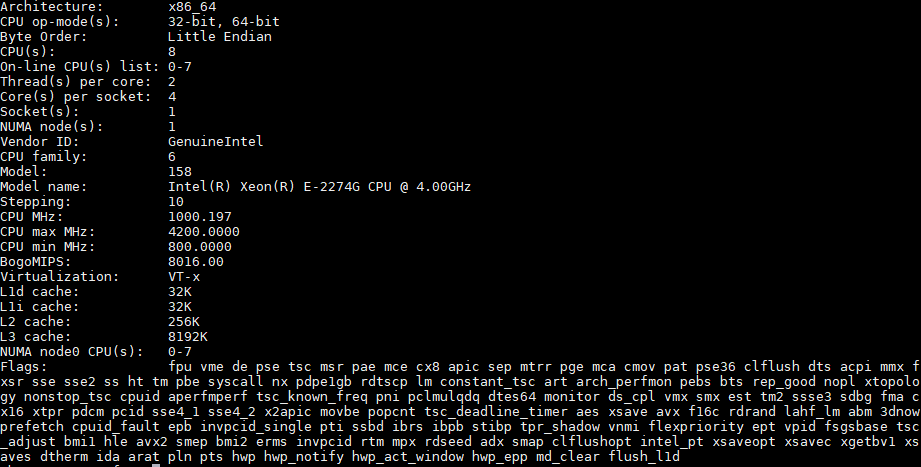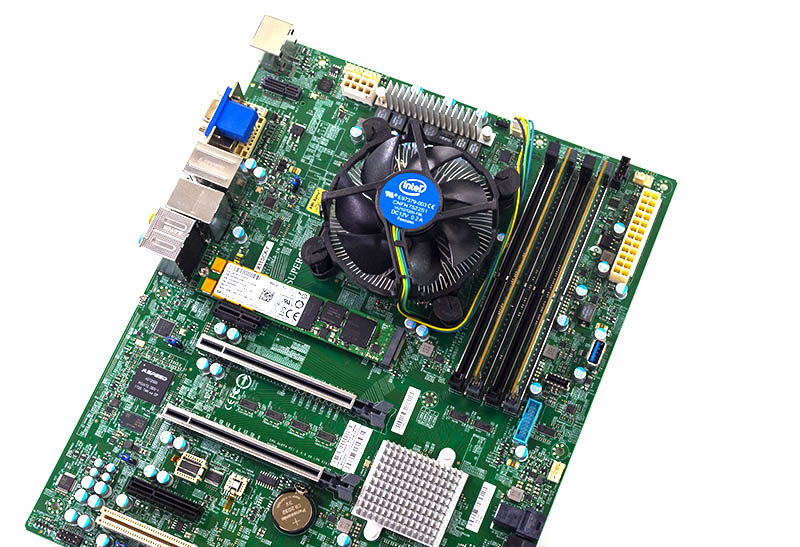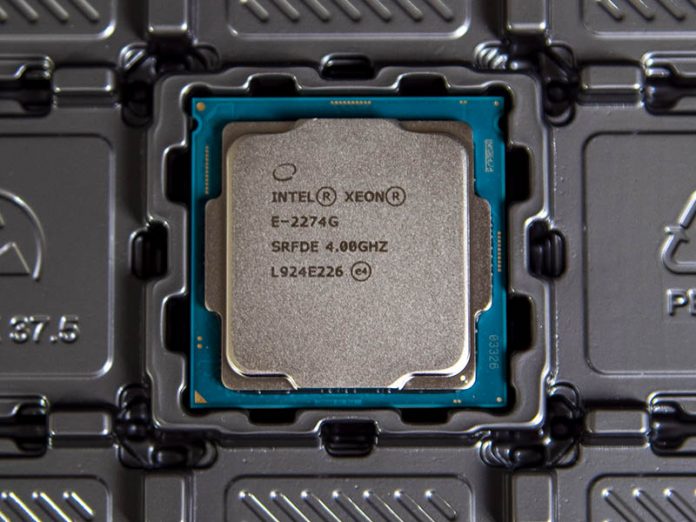The Intel Xeon E-2274G represents something simple: incrementality. If you purchased the Intel Xeon E-2174G previously, this is 200MHz upgrade on a part a year later. Nobody will complain about a 200MHz upgrade at the same price point, but we are going to discuss whether that is enough.
Key stats for the Intel Xeon E-2274G: 4 cores / 8 threads with a 4GHz base clock and 4.9GHz turbo boost. There is 8MB of onboard cache. The CPU features an 83W TDP. These are $328 list price parts. Here is the Intel Ark page for your reference.
Here is what the lscpu output looks like for an Intel Xeon E-2274G:

Intel has maintained a 4 core and 8 thread in this segment for the last decade or more. You can read about the evolution in this segment in our piece: Looking back at Intel Xeon E3-1200 V1-V6 to the New Xeon E-2100.
In 2019, a 4 core CPU is relatively small. When this segment was established, mainstream dual-socket servers had 4 to 8 cores per CPU. Now, we see 64 cores in a single CPU socket and 4 seems very small, especially when virtualization is widely accepted. Still, there is a market for a bare minimum CPU where a single physical server is needed. While the Xeon E-2200 series with the Xeon E-2288G can put 8 cores into a single socket, there is additional competition from the Intel Core i3-9100 at the low end. If one needs minimal CPU performance at a lower cost, then there are other options.
One of the biggest benefits to the Intel Xeon E-2274G is the “G” which denotes onboard graphics. For those that need a server that can do video encoding/ transcoding, having onboard graphics is important.
Test Configuration
Here is our basic configuration for this class of CPU:
- Motherboard: Supemicro X11SCA-F
- CPU: Intel Xeon E-2274G
- RAM: 4x 8GB DDR4-2666 ECC UDIMMs
- SSD: Intel DC S3710 400GB
- SATADOM: Supermicro 32GB SATADOM
The CPU itself supports up to 128GB of RAM, in a 4x 32GB configuration. We see these platforms using 32-64GB or less given cost sensitivities.

There are going to be folks who want to point to AMD alternatives. As of this writing, there are really no alternatives in this space because while AMD may have competitive CPU parts, vendors have a vibrant Intel Xeon E-2100/ E-2200/ Core i3 ecosystem. AMD needs to do some work here to catch up, but it is not a focus market for them. Single socket servers in this segment are a relatively low volume area.
Next, we are going to take a look at our Intel Xeon E-2274G benchmarks, we are then going to focus on power consumption then conclude with our final words on the processors.





The AsRockRack X470D4U2-2T looks to be a pretty competitive.
Supports AMD AM4 Socket Ryzen™ Series CPUs
Supports 4x DDR4 ECC and non-ECC UDIMM, max. 128 GB
Supports up to 6 x SATA3 6.0Gb/s (inculded 1 SATA DOM), 2 x M.2
Integrated IPMI 2.0 with KVM and Dedicated LAN (RTL8211E)
Supports2 x RJ45 10G base-T by Intel X550-AT2
Supports 2 x PCIe 3.0 x16, 1 x PCIE 2.0 x1
Together with a same priced R7 3700x
What’s wrong with using any of the numerous am4 boards that have the traces for the full 72 bit ecc memory interface and thus support ecc udimms?
But yeah, there is absolutely no valid reason for amd to neglect the fairly easily attainable possibility to trash intel in that market too. It is understandable why they went after big money first, but now that they are dominating the high end, maybe put some effort into validation and promotion of low end servers.
4 core, 8 thread, 4.0 Ghz base clock, and 8MB of cache for $328? Is this 2014?
That’s the exact same specs as the 4790K Haswell chip from 2014, even down to the price point.
DGO the big win is Out of band IPMI Port and AST2500 BMC
Still a good chip for an application server now it’s coming down to the discount market at dedicated server hosts. Many user-facing operations can still be single-threaded, and it boosts to 4.9/4.8/4.6/4.4Ghz – though perhaps less at more power with AVX2; my system will run it at 83W for 28s. Obviously if you need AVX-512, Xeon D is the way.
There’s equivalent boards, E3C246D4U2-2T or similar – the NVMe-supporting E3C246D4I-2T was reviewed here – with the AST2500.